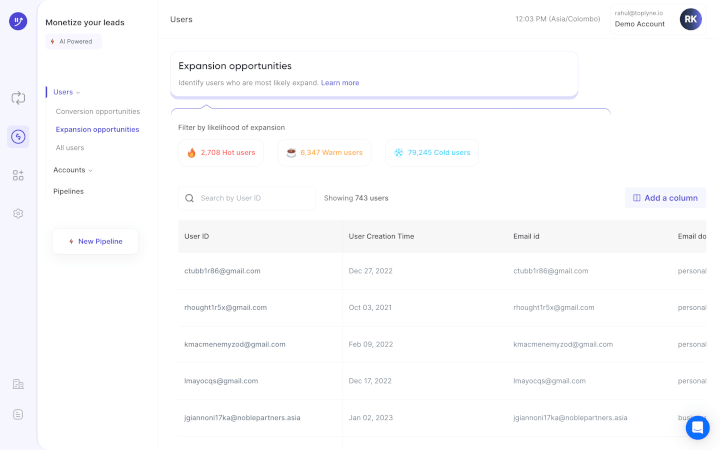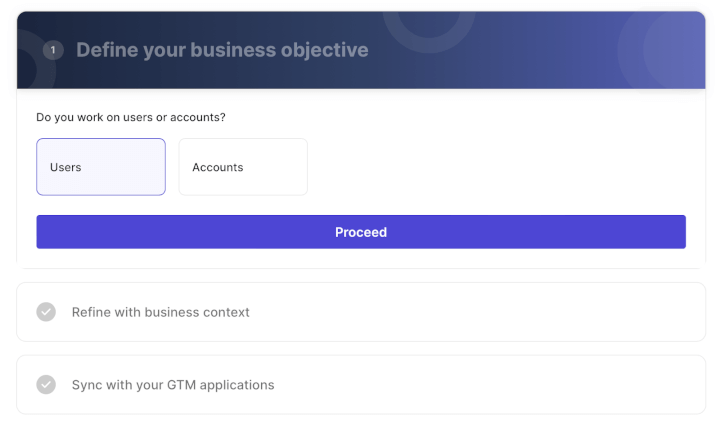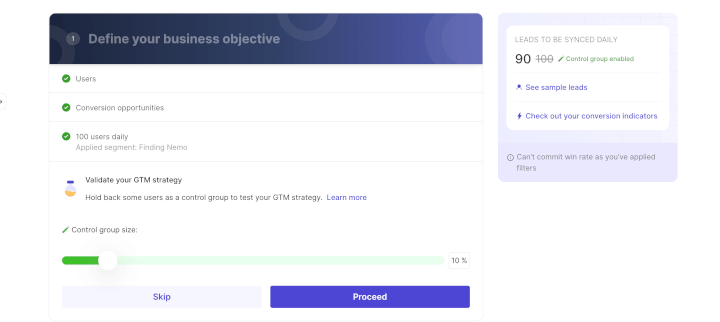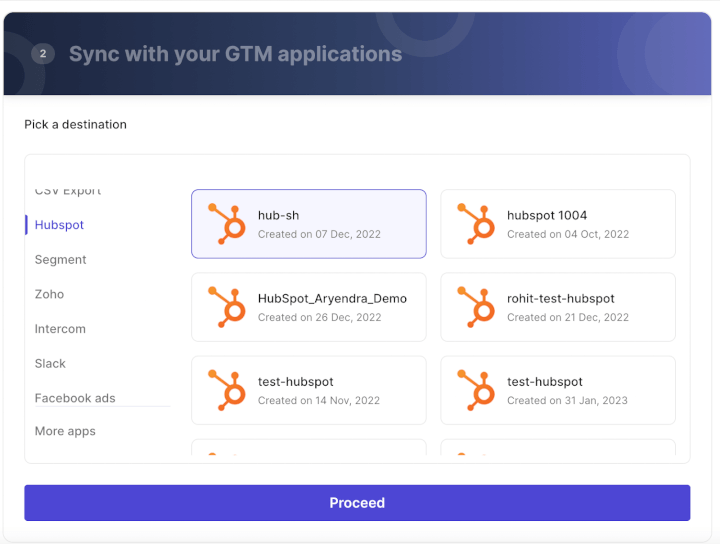What Is a Sales Qualified Lead? (+Why They’re Important)

Good news — you’re getting too many leads.
Bad news — your B2B sales reps are chasing all of them.

You need to point your sales team to only those leads who’ve shown enough interest in your product AND are ready to move into your sales process.
Yep, we’re talking about sales qualified leads.
In this article, we’ll discover what a sales qualified lead (SQL) is and how it differs from a marketing qualified lead (MQL) and sales accepted lead (SAL).
We’ll also highlight the four major criteria to help you find SQLs and delve into the hot topic in the SaaS industry — sales qualified leads vs. product qualified leads.
Finally, we’ll introduce you to an awesome tool that lets you build a pipeline of product qualified leads in no time.
Ready, set, go!
What Is a Sales Qualified Lead?
A sales qualified lead is a prospect who has shown interest in the product that goes beyond simply consuming marketing content and free offers.
The lead qualification criteria may differ based on the size and offerings of your software company. However, across the board, sales qualified leads have:
- A requirement for your product.
- Shown an interest in your product.
- Been assessed by your team to ensure they are the right fit.
- The budget to buy your product.
- The authority to make the buying decision.
A sales qualified lead is the light 💡at the end of the sales funnel, especially when you’ve too many leads clogging up your sales pipeline.
They’re the ones who respond to your sales rep with a friendly ‘Hello!’ rather than dismissing them with an indifferent ‘Huh?!’

The likelihood of a sales qualified lead (SQL) converting into a paying customer is undoubtedly higher than that of a marketing qualified lead (MQL) or sales accepted lead (SAL).
It’s because a sales qualified lead is characterized by their urgency and willingness to purchase your product rather than just a general interest in the product.
This brings us to the all-important question —
MQL vs. SAL vs. SQL: What’s the Difference?
The main difference between an MQL, SAL, and SQL is their sales readiness and position in the sales funnel.
An MQL (marketing qualified lead) knows about your product through your blogs, eBooks, how-to guides, etc. However, they may not be ready for that sale now (or ever!)
To turn this vanilla user into your next potential customer, you need to nurture them and boost their buying intent.
Your marketing team can also run a paid marketing campaign on Facebook, Google, or other platforms that direct MQLs to gated content and speed up their sales process.
A sales accepted lead is an MQL that has been approved by the marketing team and accepted by the sales department as worthy of pursuing.
However, it can’t be just any marketing qualified lead who engages with your Google ad, email marketing campaign, or any other marketing strategy.
The prospect should match your buyer persona, express a clear interest in your product, or indicate their willingness to move into the initial stages of the sales process.
And while SALs look promising, they need further nurturing by your sales team.
Think of it like this. A marketing qualified lead is like vanilla — great on its own. But if you add a few delicious toppings, you get an SAL. Then what’s SQL, you ask? An entire ice cream sundae 🍨

An SQL is a prospective customer that hasn’t only been vetted by the marketing team and sales department but also has the budget to buy your product.
In short, they’re ready for that one-on-one with your sales rep!
And for a higher lead-to-customer conversion rate, you need to pay attention to certain aspects of the lead generation and lead qualification process.
Four Key Criteria to Identify SQLs
Let’s explore the four factors to help you find the perfect SQLs and get a higher return on your time spent with every sales lead.
1. Requirements and Objectives
You could have a sales lead who is willing to purchase your product and may even match your ideal customer profile (ICP) but doesn’t wholly understand your offering.
For instance, you come across a potential customer who wants to opt for the basic plan of your time tracking tool. However, they may later realize that they’re looking for a more comprehensive solution in the form of a task management tool.
The worst part?
The customer will be unhappy with your product and your company risks getting spammed with negative reviews left, right, and center.

To avoid this from happening, here’s what you should ask your sales qualified leads:
- What are your present company goals?
- What kind of operational challenges are you facing?
- What steps are you taking to overcome them?
- Are you interested in knowing more about our product?
- How do you think our product can help you?
This will help the sales team gauge your lead’s exact requirements and define whether your product solves their problems.
2. Score
Lead scoring is a sure-shot way to separate the wheat from the chaff during sales prospecting and shorten the sales cycle.
In this, you assign specific points to every prospective customer based on their interest and buying intent. The interest level can be determined by different actions taken throughout the customer journey like:
- Viewing your product’s pricing page
- Requesting product demos
- Engaging with your inbound marketing material
Lead scoring allows B2B sales reps dedicate more time talking to a potential lead that won’t hang up on them or (worse) leave them hanging for a response.
This way, your sales department will not waste time on any unqualified lead.
Get all the deets on lead scoring and how it can help you focus on the hottest leads.
3. Action
Still waiting on the lead to book a call with your sales team?
Time for some good ol’ fashioned stalking….

Hold your horses!
Don’t break out your binoculars and an oversized hoodie yet!
Instead, use customer relationship management (CRM) tools to track the lead’s activity. It will help you find out how often they:
- Visit your website.
- Submit contact details in exchange for an offer or inbound marketing content.
- Reach out to you with questions related to the product.
The higher the lead’s interaction level, the more likely they are to purchase.
Ideally, the sales team and marketing department should work together to determine which actions qualify a prospect for the next stage in the sales process.
A product-led growth company can also rely on the product usage data that highlights:
- Which users invited other team members to the app.
- Which demographics have the best conversion rates.
- Which users have spent significant time on the pricing page.
4. Buying Intent
Ever seen someone eyeing the latest fall collection in a retail store with no intent of buying? 👗👝👖
You’ll find such window shoppers (aka prospects) checking out your products and gathering information by downloading your eBooks, white papers, and more.
However, ask yourself – does this lead have the budget to make a purchase? If not, they’re an unqualified lead.
It’s imperative for your team to weed out the prospects during lead qualification who can’t afford your product.
You can rely on the BANT (Budget, Authority, Needs, and Timeline) framework to vet your sales leads and shorten your average sales cycle.
According to the BANT criteria, a quality lead should have:
- The budget to pay for your product
- The authority to purchase your product
- A real need for your product
- An urgency to purchase your product
In the absence of an SQL qualification process, you risk pursuing leads who aren’t a good fit due to budgetary constraints, organizational challenges, or factors.
Keep scrolling to learn the other benefits of qualifying and tracking sales leads.
Why Is Tracking SQLs Important?
A software company can track SQLs to document and categorize customers based on their interactions with your product. It allows companies to receive the information they need to close deals and increase revenue.
Tracking sales qualified leads is a significant step in the sales process that you shouldn’t skip because it:
1. Saves Your Team Time
SQLs give you direction and help you know where to dedicate your time and resources. Without sales qualification, you’d end up interacting with dud leads that don’t fit the buyer persona, only to realize later:

You can also ask your sales reps to pursue qualified prospects that share traits with your existing customers in terms of their job title, demographic, and more. This may help you uncover sales opportunities and improve close rates.
2. Helps Evaluate Your B2B Marketing Effort
A thoughtful B2B marketing campaign can help nurture and convert most ice-cold traffic into piping-hot leads. 🔥
So tracking SQLs can help you determine if your marketing effort is hitting the bull’s eye or beating around the bush.
Further, the quality of SQLs can help them realize if they need to nurture the marketing lead more before passing them on to sales.
Want to craft a more data-driven marketing strategy?
Check out Toplyne, a headless AI tool that integrates with product analytics tools like Amplitude and Mixpanel. It helps companies with the right data to make informed decisions on marketing strategies and product development.
3. Improves Conversion Rates
While it's great to acquire a lot of sales leads, you’d only want to work with the right sales qualified leads.
Quality SQLs fulfill the BANT criteria, making them more likely to buy your product. They are also closest to your idea of the perfect customer.
So tracking SQLs gives you a pipeline filled with qualified sales leads and improves close rates, giving you more paying customers.
Moreover, focusing on a select few quality leads gives you more time to personalize your email marketing campaigns. It helps you tailor the message to the user and enhance the customer journey.
Essentially, the company’s revenue is determined by the quality of leads emerging from your lead generation and sales qualification process.
But the fact remains:
Regardless of how awesome SQLs are, that’s exactly what they are – sales qualified leads.
They still don’t guarantee conversions.
So if you have a reliable number of SQLs under your belt but are still finding it hard to get your beauty rest 💤 don’t fret.
We have one more addition to your conversions Swiss knife.
The laser-sharp edge of product qualified leads.
SQLs vs. PQLs: What Matters More for SaaS Companies?
A product qualified lead is someone who’s already used your product (via free trial or a demo version) and experienced its value first-hand.
PQLs make your sales team’s job easier since the lead is aware of your product’s capabilities and how it can help them overcome operational challenges.
Further, the feedback or critique from your product qualified lead can lead you to that moment of epiphany — “OMG, how did we miss that?!”
It can be related to the product experience, lack of functionality, feature limitations, and more.
Mind you, these reviews can prove invaluable to the betterment of your product.
On the other hand, SQLs may or may not have used your product before. So you may be relying mostly on your sales team’s powers of persuasion to convince the SQL to make the purchase.
Additionally, most SaaS customers aren't interested in flashy marketing gimmicks. Instead, they want to try your product before they decide to buy. That’s why SaaS companies value PQLs way more than SQLs.
Further, sales calls can be shaped by your PQL’s product usage. Over time, it can also help you identify which actions are highly correlated with conversion to paid accounts.
Long story short — nurturing PQLs can give you high-value and long-term customers.
And that’s where Toplyne comes in.
Build a Powerful PQL Pipeline with Toplyne
Toplyne is a one-of-a-kind headless sales tool that helps create a sleek pipeline of product-qualified leads. It helps increase win rates, identify conversion opportunities, AND boost net revenue retention (NRR).
Sounds insane, right?
The tool’s AI identifies behavioral patterns of any lead via in-product activity. Your team gets access to the product usage data and reaches out to only quality leads who are most likely to convert in your sales pipeline.
And a pipeline saturated with the best PQLs will (automatically) boost your sales conversion rate!
But wait, there’s more to this awesome tool.
Here’s how companies like Canva and Vercel generate sales pipeline from their self-serve funnel using Toplyne:
- Step 1/7: Create monetization playbooks to surface conversion and expansion opportunities (leads most likely to convert to paying customers, and teams most likely to grow into larger teams)

- Step 2/7: Choose the right leads to target – users (individual users) or accounts (a group of users with an organization).

- Step 3/7: Select the frequency at which you would want leads synced in your GTM apps.

- Step 4/7: Define how many leads you want by either the number of leads or your expected win rate, depending on your sales capacity and GTM strategy.

- Step 5/7: Build custom segments - Build custom segments based on And/Or logic at the deepest level of sub-properties within your product analytics.

- Step 6/7: Validate your GTM strategy - Hold back some users as a control group to test your GTM strategy.

- Step 7/7: Sync your product qualified pipeline into your GTM destinations - CRMs, sales & marketing execution tools, and customer engagement platforms.

PQLs: the Secret Sauce for High-quality Leads
When you focus on SQLs, you don’t lose potential leads. The sales team can either close the deal or send it back to the marketing department for further nurturing.
But for B2B SaaS, you need more. Yep, we’re talking about PQLs.
PQLs represent the list of highly qualified sales leads.
Because they have experienced your product (and found it useful), they are more likely to convert than a marketing qualified or sales qualified lead.
And for your sales reps, checking out a long list of PQLs can be as exciting as opening Christmas gifts! 🤩
The only nagging question — how do you find these remarkable Product Qualified Leads?
With Toplyne!
Besides building a smooth product-qualified pipeline, the tool lets you boost engagement and reach out to leads right within your app.
Sign up for Toplyne for free today to get your hands on the best leads and close every sale faster!



.svg)









.png)